WBWC Urges Work on Border-To-Border Trail
Ann Arbor park advisory commission meeting (Aug. 20, 2013): In a session that one member described as the “shortest meeting ever,” park commissioners heard presentations and updates, but had no action items on their agenda.
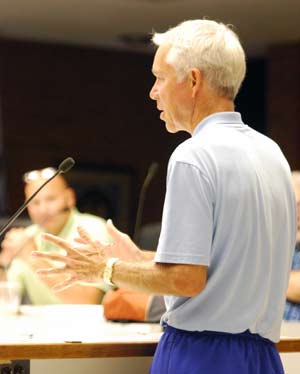
Larry Deck of the Washtenaw Bicycling and Walking Coalition gave a presentation to the Ann Arbor park advisory commission about the Border-to-Border trail. (Photos by the writer.)
The main presentation focused on the Border-to-Border trail connections in Ann Arbor. The trail runs roughly along the Huron River from Livingston County in the north to Wayne County in the east, using paved shared-use paths, unpaved paths and bike lanes.
Larry Deck from the Washtenaw Bicycling and Walking Coalition highlighted three areas that WBWC has identified as high priorities: (1) between Bandemer Park and Barton Park/Huron River Drive (the B2B trail ends at the north edge of Bandemer Park); (2) near the intersection of Fuller Road and Maiden Lane; and (3) near the Fuller Road bridge over the Huron River.
Another WBWC priority is to improve the bicycling connections between the University of Michigan’s central and north campuses.
Deck suggested that PAC consider a resolution recommending to city council that these projects be designed and funded, and in general renew the priority of the B2B trail along the Huron River greenway. It’s been a city priority for decades, he noted, but it’s good to have a reminder of that.
Discussion among commissioners focused on the challenges of crossing railroad tracks at various points along the B2B route, as well as interest in coordinating with other projects like the recommendations of the North Main Huron River corridor task force.
During the meeting, commissioners also got an annual update from George Taylor, president of the Cobblestone Farm Association, as well as briefings from PAC’s dog park and downtown park subcommittees. Results from surveys to solicit public input for both subcommittees are now available, and will be analyzed by commissioners and staff in preparation for upcoming public forums. [.pdf of 306-page dog park survey results] [.pdf of 110-page downtown park survey results]
Two public forums are scheduled for the downtown park project: On Monday, Sept. 9 in the basement of the downtown Ann Arbor District Library, 343 S. Fifth, from 6:30-8:30 p.m., and on Wednesday, Sept. 18 at city hall’s basement conference room, 301 E. Huron, from 6:30-8:30 p.m.
The dog park subcommittee – which is looking for a possible location for a third dog park – will hold a public forum on Wednesday, Sept. 11 at 7 p.m. at Cobblestone Farms, 2781 Packard. In noting the history of opposition to proposals for a dog park at West Park, Tim Berla wondered whether it would be possible to locate a dog park anywhere near a residential neighborhood. It’s a “classic Ann Arbor trap,” he said – everyone is in favor of it, until something specific is proposed and the neighbors say no.
In his manager’s report, Colin Smith highlighted several upcoming events. The annual season-closing “dog swim” at Buhr Park pool will be held on Sept. 4 and Sept. 5 from 3-8 p.m. On Sunday, Sept. 15 at 1 p.m. in Liberty Plaza – the downtown park at Division and Liberty – a grand opening will be held for the “sensory garden” there. It’s a project of the Ann Arbor commission on disability issues, in collaboration with the city’s adopt-a-park program and the University of Michigan Matthaei Botanical Gardens.
Smith also noted that the popularity of Argo Cascades has led to a shortage of parking in that area. As a result, beginning Labor Day weekend the staff will start using a portion of Longshore Park to park cars. It’s a short-term measure while the staff seeks longer-term solutions, he said.
Border-To-Border Trail
Larry Deck from the Washtenaw Bicycling and Walking Coalition (WBWC) gave a presentation on the Border-to-Border trail connections in Ann Arbor, highlighting some areas that need attention.
WBWC has been an advocacy organization, Deck said, and he briefly described some of the work that the group has done, including advocating for changes to the city’s crosswalk ordinance. Members have participated in the city of Ann Arbor’s alternative transportation committee, Ypsilanti’s non-motorized advisory committee, the Washtenaw County greenways advisory committee, and other public groups. WBWC also partners with other entities, he said, including the Ann Arbor Bicycle Touring Society, Center for Independent Living, and the getDowntown program.
The Border-to-Border (B2B) trail, an initiative spearheaded by the Washtenaw County parks & recreation commission, runs roughly along the Huron River from Livingston County in the north to Wayne County in the east, using paved shared-use paths, unpaved paths and bike lanes. About half of it is complete, Deck reported, with more segments in the works.
WBWC has prioritized parts of the trail countywide, Deck said. Those priorities are based on several factors: (1) connecting centers of population and activity; (2) connecting to the existing Border‐to‐Border trail; (3) accommodating the needs of all people and abilities; (4) countywide significance; (5) near‐term feasibility; and (6) whether trails are prioritized in current plans by local municipalities, like Ann Arbor’s non-motorized transportation plan.
Outside of Ann Arbor, Deck noted that about 7 miles of trail between Dexter-Huron Metropark through Dexter and out to North Territorial Road will be completed by the end of this year. There are a lot of projects in the Ypsilanti area too, he said, to pull the trail segments together.
Within Ann Arbor, one WBWC priority is to improve the bicycling connections between the University of Michigan’s central and north campuses. Deck reported that WBWC is working with staff at the city and university on this project.
But Deck focused on three other primary areas that WBWC has identified as problems: (1) between Bandemer Park and Barton Park/Huron River Drive (the B2B trail ends at the north edge of Bandemer Park); (2) near the intersection of Fuller Road and Maiden Lane; and (3) near the Fuller Road bridge over the Huron River.
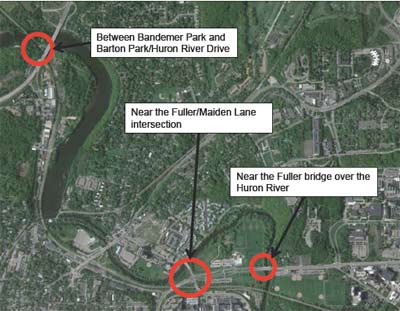
Three problem areas in Ann Arbor for the Border-to-Border trail, as identified by the Washtenaw Bicycling and Walking Coalition.
Some of the city’s plans also identify these areas as locations that need to be addressed, Deck said. For example, the 2007 non-motorized plan calls for a new pedestrian/bicycle bridge over the Huron River just west of Maiden Lane at Fuller, plus trail connections at three existing underpasses in that area. When the existing bridges were built in the 1980s, they included wide concrete paths underneath the bridges, in anticipation that connection to those trails would be completed. “But 30 years later, we still need to complete them,” he said.
The city’s parks and recreation open space (PROS) plan also shows trails at all of those underpasses in the Fuller/Maiden Lane and Fuller/Huron River area. In addition, the PROS plan indicates plans for an underpass under the railroad, connecting Bandemer and Barton parks.
Deck showed PAC members a series of maps that indicated how B2B connections might be achieved in these three areas. In the case of the Fuller Road/Maiden Lane area, the goal is to avoid the “nasty” intersection where pedestrians and cyclists are expected to cross now. WBWC also hopes to see some existing shared-use paths widened to 14 feet. [The Fuller Road and Maiden Lane intersection has one of the higher volumes of pedestrian traffic in the city.]
Deck noted that demand is high, especially in the Fuller Road/Maiden Lane area. A 12-hour traffic count at that intersection in 2006 – conducted between 7 a.m. and 7 p.m. – recorded 1,767 pedestrians and 443 bicyclists on Fuller Road, plus 2,694 pedestrians and 292 bicyclists at Maiden Lane. More than 90% of the bicyclists weren’t using the road, but were on sidewalks. “So there is a need for improving these facilities,” Deck said. He estimated the cost at about $500,000 for that area.
Making connections at Bandemer and Barton parks would be more expensive, Deck noted – likely $2 million or more, because it involves the railroad tracks. Currently, there’s an “informal” crossing and path that Deck described as “an accident waiting to happen.” With higher-speed trains coming, it will be even more risky, he said. There are other alternatives, Deck noted, but none are as desirable as a railroad underpass.
Deck said that of the projects considered by the city’s North Main Huron River corridor task force, the highest priority for WBWC is the Bandemer/Barton connection. Lower priorities, from WBWC’s perspective, include: (1) a railroad underpass near Main & Depot; (2) sidewalk repair and possible extension in the North Main Street area; (3) a park on the DTE site, with a trail and bridge over the Allen Creek; (4) a railroad gate at Lakeshore Drive; (5) a crosswalk to Bluffs Park; and (6) Main/Depot intersection improvements.
In terms of financing, Deck told PAC there was funding available for significant projects, especially for regional initiatives. Possible sources include the Michigan Dept. of Natural Resources Trust Fund, the federal transportation alternatives program, Washtenaw County parks & recreation, local transportation funding, the city’s park maintenance and capital improvements millage, and the University of Michigan.
Deck suggested that PAC consider a resolution that would recommend to city council that these projects be designed and funded, and in general renewing the priority of the B2B trail along the Huron River greenway. It’s been a city priority for decades, he noted, and it’s good to have a reminder of that.
Border-To-Border Trail: Commission Discussion
Alan Jackson told Deck that there are different groups with different priorities, and he wanted to give some pushback on the WBWC’s priorities. He wondered whether all bicyclists would use the B2B connections, or whether it would be better to spend money on road improvements, for those cyclists who ride on the roads. At Fuller Road and Maiden Lane, for example, it’s possible to cross the road, even though it’s difficult, he said. In contrast, the railroad crossing between Barton and Bandemer is a real impediment.
Deck replied that bicyclists do have the right to be on the road, and that’s what many bicyclists do. But a lot of people don’t ride their bicycles because they’re afraid to go on the road, especially at busy intersections like Fuller and Maiden Lane. Deck said he does a lot of biking – he rode to the PAC meeting, for example – but he prefers a good trail, if it’s available. He thinks most people would prefer to use a trail.
Jackson also raised the issue of the route between UM’s central and north campus, saying he agreed it wasn’t a good connection. He wondered if WBWC has worked with the university in any substantive way, and did UM officials indicate they’d be willing to fund such a project? “Certainly that would help us in our decision-making,” Jackson said.
Deck replied that some WBWC members recently met with UM staff and Eli Cooper, the city’s transportation program manager. There’s no indication of funding, but UM is willing to work on these issues, he said.
Bob Galardi told Deck that he’s involved in the Allen Creek Greenway Conservancy. If the greenway gets built, it would go through downtown Ann Arbor and allow a lot of people to connect to the B2B trail. One of the difficult connections is at Main & Depot, and he wondered what Deck thought about that. Deck replied that the proposed greenway would enhance the B2B trail, though he saw the greenway as a longer-term vision. A good first step would be to figure out a way to cross the railroad tracks near Main & Depot. That would make it easier to justify funding for other projects in that area, Deck said.
Galardi pointed out that getting across Main Street is another challenge. He was on the B2B trail the previous day, Galardi said. “It’s so nice, but getting to it – for a big population that are Ann Arbor residents, at least – is not easy.” Deck suggested looking at building a passage underneath the Main & Depot intersection and the railroad, though he acknowledged it would be very expensive.
Tim Berla agreed that there were a lot of expensive projects related to these connections, but the city should get some of the projects moving. The biggest challenge is the railroad tracks, he said, and it should be the highest priority. Berla recalled that Amy Kuras, the city’s park planner, had worked on that a few years ago. How should the city proceed if they wanted to get this project “back on the tracks,” he quipped.
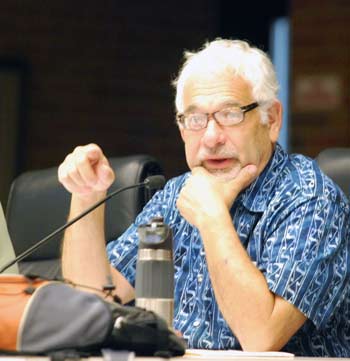
Ann Arbor park advisory commissioner Bob Galardi also serves on the Allen Creek Greenway Conservancy board.
Kuras recalled that the city did an engineering study about eight or nine years ago, and negotiated with the railroad to get some preliminary commitments for a pedestrian crossing. The biggest issue is that the railroad – which is now under new ownership – wouldn’t allow any changes that might interrupt train service, Kuras said. She’d spent a lot of time lining up potential federal, state and local funding sources, but then the city decided not to move forward with the project. The estimated cost was around $2 million.
Berla noted that a crossing had seemed possible at the time. He suggested that PAC could weigh in and recommend it as a priority, so that Kuras could re-initiate the project. Kuras cautioned that a lot has changed since her previous work, including priorities that are being recommended by the North Main Huron River corridor task force. So it would be important to look at the bigger picture and coordinate with other entities, like the state and University of Michigan. Berla felt it would be a good long-term priority.
Julie Grand, who has served on the North Main Huron River corridor task force, clarified that one of that group’s recommendations will be for a railroad crossing at Fourth & Depot, to connect to the DTE site and on to the Huron River. [The city hopes that the land now owned by DTE, next to the Huron River and across from Argo Cascades, will eventually become parkland.] There might be grant funding for that project, she noted, which might make it rise in terms of priorities.
Kuras added that three locations have been considered for pedestrian underpasses at the railroad tracks: (1) at Nichols Arboretum; (2) between Barton and Bandemer parks; and (3) at Fourth & Depot to connect to the DTE property. A bridge over North Main Street has also been discussed, she said. The challenges with bridges include the clearance needed for the trains, and making the ramps ADA accessible. And any connection needs to be done in a way that makes people want to use it, she added, or else millions of dollars will be spent and people will just use the current informal routes, if those are more convenient.
Colin Smith, the city’s parks and recreation manager, said there’s been a lot of attention over the past year regarding the B2B trail, the area around Main Street and the Allen Creek greenway. A lot of opportunities have been identified, and PAC can help figure out where the city should focus when applying for grants to pursue some of these projects, he said.
Outcome: This was not a voting item.
Cobblestone Farm Association
George Taylor, president of the Cobblestone Farm Association, delivered a brief update to the commission, along with a written annual report for 2012. [.pdf of 2012 annual report] The association is a nonprofit that works in partnership with the city of Ann Arbor, which owns the Cobblestone Farm property and buildings at 2781 Packard Road, adjacent to Buhr Park.
Noting that it seemed like ancient history now, Taylor reported that in 2012 the city hired an architect to assess the facilities, and determined that roof replacement and work on the windows were priorities. Taylor contacted Preservation By Design to look at the windows. Soon after that, one of the windows was broken from an attempted break-in, so that window was replaced by PBD. [On Jan. 7, 2013, the city council approved a contract to replace the roofs at Cobblestone Farm's event barn and the Tincknor-Campbell House.]
One of the newest activities at the farm is a weekly farmers market, Taylor reported. It’s held every Tuesday from 4-7 p.m., and there have been up to 300 people on some Tuesdays, with 10-20 vendors. There are arts and crafts for kids, bicycle repair, free music. He invited commissioners to drop by later that day.
Among other activities held at Cobblestone, Taylor highlighted the first craft show, which had five vendors. They’ll all be coming back for an event in September, he said.
Taylor reported that the parks system rents out the farm for lots of weddings. The association is tapped into the resource, he said, and rents out the Tincknor-Campbell House for two hours for wedding parties to use as a staging area and tour, for a $75 fee. “It’s been a great revenue source from us,” he said. Many people who come say that they’ve lived in Ann Arbor all their lives, but haven’t ever been to the Cobblestone Farm house, he said. “The word’s getting out there that Cobblestone Farm is probably one of the best kept secrets of the city of Ann Arbor.”
Next year will be mark the association’s 40th year in partnership with the city of Ann Arbor, which owns the facility. The group is planning a large party at its annual meeting in April, and Taylor invited commissioners to attend. He noted that there have been ups and downs over the years at Cobblestone, but now “everything is really looking up.” He thanked the parks staff for their work.
Downtown Park Update
PAC received a briefing on the downtown park subcommittee from Ingrid Ault, who chairs that group. Other members are Julie Grand, Alan Jackson and Karen Levin.
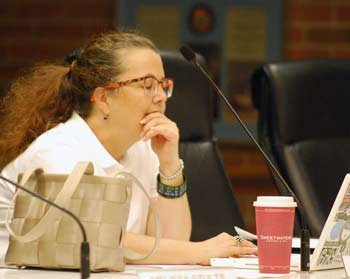
Ann Arbor park advisory commissioner Ingrid Ault serves on the dog park subcommittee and chairs the downtown park subcommittee.
The online survey has closed, with about 1,600 responses. The results are posted on the subcommittee’s website. [.pdf of 110-page downtown park survey results].
A lot of the questions had been open-ended, so that the community could drive the conversation, Ault said. The subcommittee members and parks staff will be analyzing and categorizing the results.
The subcommittee’s next meeting is on Tuesday, Sept. 3 at 5 p.m. at city hall’s 6th floor conference room. They’ll be discussing how to do more community outreach, now that the survey results are in, Ault said. The meetings are open to the public.
Two public forums are scheduled as well: On Monday, Sept. 9 in the basement of the downtown Ann Arbor District Library from 6:30-8:30 p.m., and on Wednesday, Sept. 18 at city hall’s basement conference room from 6:30-8:30 p.m.
Dog Park Update
PAC’s dog park subcommittee consists of Ingrid Ault, Karen Levin and Missy Stults. Stults and Levin did not attend PAC’s Aug. 20 meeting, so Ault gave the update. A survey to get public input closed on Aug. 12, and over 1,500 responses were received. The subcommittee will next meet on Friday, Aug. 23 at city hall to discuss the results. Another meeting is set for Sept. 11 at Cobblestone Farm.
The survey had asked a range of questions, Ault said, including whether respondents used the existing dog parks and what people like or don’t like about them. The survey also asked for feedback on specific parks that might include a dog park. Julie Grand noted that about two-thirds of the respondents were female.
Colin Smith, the city’s parks and recreation manager, said the number of responses for this survey and for the downtown park survey had been extremely high, compared to other city surveys. Both subcommittees had done outreach to solicit input.
Tim Berla asked whether the results are available to the public. Smith reported that the results are posted on the subcommittee’s website. [.pdf of 306-page dog park survey results] Berla suggested that in addition to making the information available in a .pdf file, the raw data should be posted in a format so that anyone could download it into a spreadsheet and do their own analysis. He felt it’s important to “just let the ideas into the marketplace and people can figure it out.”
Grand noted that it’s also important to remember that the survey is just one piece of input. It wasn’t intended as a way for people to vote, she said. The survey will be used to help inform PAC’s recommendation, along with feedback at public meetings and other types of information.
Berla then alluded to the prior recommendation to put a dog park in West Park. [In 2012 and then earlier this year, two locations for a new centrally-located dog park were explored at West Park, but ultimately rejected because of protests from nearby residents as well as the New Hope Baptist Church, which is located across the street from the park.] Based on what happened at West Park, he said, “people are going to say, ‘Yeah, I’m in favor of dog parks – just not anywhere near my house.’” It seemed like almost an intractable problem to him. The city’s two existing dog parks, on the far north and south sides of town, aren’t near anyone’s house, he noted.
Berla wondered if there was any way to move forward. It’s a “classic Ann Arbor trap,” he said – everyone is in favor of it, until something specific is proposed and the neighbors say no.
Grand replied that’s why the dog park subcommittee is taking these steps to get more input and look at the broader policy issue. She thought that would make it easier to move forward with a decision. Amy Kuras, the city’s park planner, expressed interest in developing standard criteria for things like a recommended distance between a dog park and residences. That’s something the subcommittee hopes to develop out of this public process, she said.
In terms of input, the day after PAC’s meeting, the parks & rec staff received an email from Tom Egel, a resident who lives near West Park, with the subject line “Ode to the PAC Dog Park Subcommittee”:
I do not want a loud dog park I do not want to hear dogs bark Parks are for people (and dogs on leashes) Not for a fence that's filled with feces I live in Ann Arbor and enjoy when it's quiet Walking my dog means we don't have to diet We do not need a dog park in "The Ann" For those who insist, I have a good plan: There's plenty of land on the outskirts of town Where dogs can run free and play with more hounds People with dogs will come from afar No need to walk there, 'cause they have a car For those in the city, you can take a nice walk You'll meet other dogs as you circle the block So give up this obsession (some call it a lark) To insist on a centrally located dog park The residents will thank you, to say the very least As we relax and enjoy our quiet and peace
Egel had spoken against locating a dog park at West Park during PAC’s March 19, 2013 meeting.
Communications & Commentary
There were several opportunities for communications from staff or commissioners during the Aug. 20 meeting. No one spoke during the two slots available for public commentary.
Communications & Commentary: Officer Elections
Julie Grand, PAC’s current chair, reminded commissioners that officer elections would be held at PAC’s Sept. 17 meeting. She encouraged anyone who is interested in holding an office to talk to current officers, including herself.
Ingrid Ault is vice chair. Grand’s term on PAC ends on Oct. 18, 2013.
Communications & Commentary: Manager’s Report
Colin Smith, the city’s manager of parks and recreation, gave several brief updates on upcoming events. The annual season-closing “dog swim” at Buhr Park pool will be held on Sept. 4 and Sept. 5 from 3-8 p.m. Even if you don’t own a dog, it’s pretty fun to watch, he said. Local businesses are providing prizes for raffles.
On Sunday, Sept. 15 at 1 p.m. in Liberty Plaza – the downtown park at Division and Liberty – a grand opening will be held for a “sensory garden” there. It’s a project of the city’s commission on disability issues, in collaboration with the adopt-a-park program and the University of Michigan Matthaei Botanical Gardens.
Smith also highlighted the grand openings held earlier this summer for the Ann Arbor skatepark at Veterans Memorial Park, and for the newly renovated ballfields at Vets, West Park and Southeast Area Park.
Attendance at the city’s pools has been down in August because of the cooler weather, Smith reported. On the other end of the spectrum, the Argo Cascades has been extremely busy, he said. In July of 2013 compared to July 2012, operations at the Argo livery increased by 52%.
That has resulted in an extreme shortage of parking, especially on the weekends. As a result, beginning Labor Day weekend, the staff will start using a portion of Longshore Park to park cars, Smith said. They expect to accommodate up to 50 vehicles there.
The parks staff will be looking for longer-term solutions, Smith noted, but in the short term, that’s the plan. Part of the problem now is that people are parking on Longshore Drive, which narrows the road and limits the access of emergency vehicles.
Present: Ingrid Ault, Tim Berla, Bob Galardi, Julie Grand, Alan Jackson, Graydon Krapohl, Jen Geer and councilmember Mike Anglin. Also Colin Smith, city parks and recreation manager.
Absent: Karen Levin, Missy Stults and Christopher Taylor (ex-officio).
Next PAC meeting: Tuesday, Sept. 17, 2013 at 4 p.m. in the city hall second-floor council chambers, 301 E. Huron St., Ann Arbor. PAC’s land acquisition committee meets on Tuesday, Sept. 3 at 4 p.m. [Check Chronicle event listing to confirm date]
Next downtown park subcommittee meeting: Tuesday, Sept. 3 at 5 p.m. at city hall’s 6th floor conference room. Two public forums are scheduled as well: On Monday, Sept. 9 in the basement of the downtown Ann Arbor District Library, 343 S. Fifth, from 6:30-8:30 p.m., and on Wednesday, Sept. 18 at city hall’s basement conference room, 301 E. Huron, from 6:30-8:30 p.m. More information about that group is on the subcommittee’s website.
Next dog park subcommittee meetings: Friday, Aug. 23 at 2:30 p.m. at city hall’s first floor north conference room; and on Wednesday, Sept. 11 at 7 p.m. at Cobblestone Farms, 2781 Packard. More information is on that group’s website.
The Chronicle survives in part through regular voluntary subscriptions to support our coverage of public bodies like the Ann Arbor park advisory commission. If you’re already helping The Chronicle with some financial green, please encourage your friends, neighbors and coworkers to do the same. Click this link for details: Subscribe to The Chronicle.




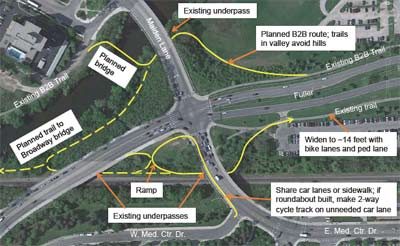
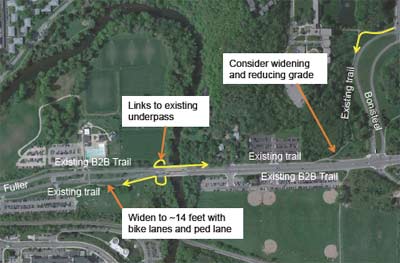


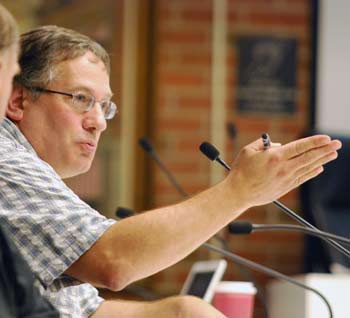
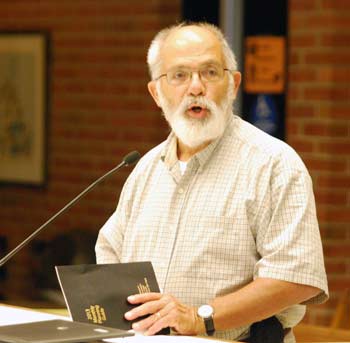
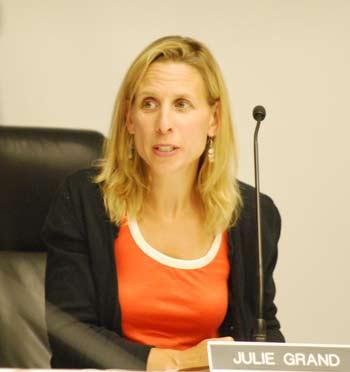
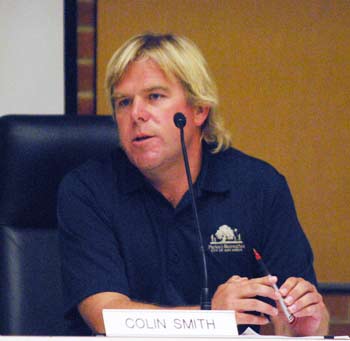
As a frequent B2B user, I appreciate Mr. Deck’s efforts to draw attention back to these long term PROS plan projects that continually get bumped down the priority list.
Citizen survey’s show B2B trail improvements as one of the top citizen priorities, yet newer parks projects, bike lanes, etc. seem to continually crowd out the funding and resolve for these older much needed B2B projects.
Perhaps Ms. Grand and the North Main Task force can clarify why a pedestrian tunnel right next to the existing Broadway Bridge (at Fourth and Depot) should have priority over the proposed tunnel at Bandemer & Barton where no safe alternative railroad crossing exists?
Why spend millions of greenbelt funds on acquiring Camp Hilltop and Bluffs Park but fail to provide safe pedestrian access to these newer parks? Why not focus on improving access to parks we already own versus hypothetical parks like DTE?
As someone who first read the city’s CIP and got excited about “all the improvements that were coming in a few years,” I have to concur that there seems to be no actual urgency to fix this. Every year they get pushed farther out with no funding identified.
I very much appreciate WBWC’s efforts to push this issue and the reporting on this issue, whether the priority order is right or not.
Without commenting on relative priority, I do actually think making it possible to bypass the Fuller Road / Maiden Lane intersection would be a huge win. For parents with small kids, a key feature of the B2B trail is the ability to go on a long ride without stressing about roads.
Obviously, figuring out how to get from downtown/westside to B2B is critical. Likewise figuring out how to get from Bandemeer to Barton would be a huge win.
Thanks to the Chronicle for its excellent coverage of local government. Thanks also to the Park Advisory Commission (PAC) for sharing the data it gathered through its Downtown Park and Open Space Survey. While commission chair Julie Grand is correct that this wasn’t a vote, it is the clearest measure we have of how the community feels about downtown parks. I hope that people will use the link provided above to look at the survey responses.
I would like to correct one item in the Chronicle coverage. I was able to attend part of the August 20 PAC meeting. The discussion of the dog park and downtown park surveys was a little confusing and commissioner Ingrid Ault served on both of the subcommittees so she spoke knowledgeably about both surveys.
However, when commissioner Ault said that the questionnaire had “lots of open questions because we didn’t want to drive the conversation,” she was referring to the dog park survey. The downtown park and open space survey had only one wide open question, “Please provide additional ideas or comments.” Of the 1,600 respondents, 618 people wrote an answer to this question.
I’m a member of the Library Green Conservancy, a group of Ann Arborites who would like to see a park or public open space of some kind on a portion of the publicly owned Library Lot (on top of the new underground parking structure). We were encouraged to see that so many of the survey respondents shared the opinion that this would be an ideal space for a town square. We look forward to continuing the community conversation about downtown open space during the PAC’s public meetings on September 9 and 18.
Basically, any of the proposed B2B enhancements would be very nice. I hope there’s progress on one or more of them soon.
I would like to comment on the city’s practice of relying on on-line-only surveys to which respondents are limited and to a large extent self-selected.
Surveys like these are a dis-service, if not an insult, to the thousands of citizens who don’t know about them, don’t have internet access, or don’t have time to respond.
These surveys are not valid measures of city-wide opinion. They are measures of what those most interested in the topic think; that “interest” is usually a strong bias in favor of, or against, what the survey covers. Those who take the survey are those who have been informed of the survey by interest groups. While this may be useful information, it should not be treated–as it often seems to be–as “what the people want.” This applies to topics such as downtown parks and greenspace, dog parks, the greenway along North Main, and downtown zoning.
A valid survey of public opinion takes time, skill, effort, and money; is done by phone or mail; includes a representative sample of the population; has followup; and asks carefully crafted questions to determine opinion on specific topics.
I ask decision-makers not to take such surveys for anything more than what they are: a quick measure of what those most interested in a topic think. They are not a way to decide what is best for everyone.
I heartily agree with (5). The problem is magnified by certain reporters (none with this publication) who then write headlines saying, “Ann Arbor residents want…” thus validating the survey and its conclusions.
@6: Ditto. The use of the word “survey” doesn’t help either, especially with the word “public”.